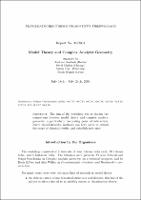| dc.date.accessioned | 2019-10-24T12:57:18Z | |
| dc.date.available | 2019-10-24T12:57:18Z | |
| dc.date.issued | 2004 | |
| dc.identifier.uri | http://publications.mfo.de/handle/mfo/2854 | |
| dc.description.abstract | The aim of the workshop was to discuss the connections between model theory and complex analytic geometry, a particularly fascinating point of interaction, where model-theoretic methods can both serve to extend the scope of classical results, and establish new ones. Introduction by the Organisers The workshop consisted of 2 tutorials of four 1-hours talks each, 10 1-hours talks, and 5 half-hour talks. The tutorials were given by Ya’acov Peterzil and Sergei Strachenko on Complex analytic geometry, an o-minimal viewpoint, and by Boris Zil’ber and Alex Wilkie on Pseudoanalytic structures and Hrushovski’s construction. For many years there were two main lines of research in model theory: • the abstract study of mathematical structures and theories, this line of the subject is often referred to as stability theory or classification theory; _x000c_1846 Oberwolfach Report 35/2004 • applications to the study of definability in concrete mathematical structures (like algebraically closed fields, the real field or the field of p-adic numbers). At first, only the most basic tools from the general theory were needed in applications, but, over the last ten years, some of the most sophisticated ideas from stability theory have played an important role in applications, most notably Hrushovski’s proof of the Mordell-Lang Conjecture for function fields. At the same time, these applications have given us new examples of stable structures which have led to new insights in the general theory. We shall briefly describe some of the recent work. Compact Complex Spaces. Zil’ber showed that a compact complex space equipped with all analytic relations is an ω-stable structure with quantifier elimination. He and Hrushovski showed that any strongly minimal set definable in these structures is either locally modular or closely related to the field of complex numbers. This type of dichotomy is the fundamental insight in many of the modern applications of model theory. Pillay began the systematic model theoretic study of these structures and was able to show that many interesting model theoretic phenomena arise naturally in this context. For example, simple non-algebraic tori are exactly the locally modular groups. In addition to giving us new examples of locally modular strongly minimal sets, this result led Pillay to a model theoretic methods to extend Falting’s theorem to a proof of Mordell-Lang Conjecture for complex tori. Pillay, in collaboration with Scanlon and Kowalski, have carried on a detailed model theoretic analysis of the groups definable in compact complex spaces, their results extend and generalize Fujiki’s work on meromorphic groups. A highlight of this work is Pillay and Scanlon’s proof that any meromorphic group is an extension of a complex torus by a linear algebraic group, a generalization of Chevalley’s theorem for algebraic groups. Recently Pillay was able to show how results of Campana and Fujiki on cycle spaces leads to a relatively easy proof of the dichotomy theorem for strongly minimal sets. With this as a model he and Ziegler were able to find new proofs of the dichotomy theorem in several other important settings (differential fields, difference fields of characteristic 0) that greatly simplify and offer new insights to some applications of model theory to diophantine geometry. In model theory one often needs to not only understand the structures we are studying but also their nonstandard extensions. While these extensions have no classical analogs, problems about nonstandard extensions often give rise to interesting classical problems about uniformity. An important recent result in this direction is Moosa’s proof of the nonstandard Riemann Existence Theorem. Quasi-analytic structures. Zil’ber originally conjectured that the dichotomy property was true for all strongly minimal sets. Hrushovski refuted this by giving a very combinatorial construction of a counterexample. Zil’ber’s current research program is designed to show that the type of examples constructed by Hrushovski actually arise naturally. The first major success of this program was recently | |
| dc.title | Model Theory and Complex Analytic Geometry | |
| dc.rights.license | Dieses Dokument darf im Rahmen von § 53 UrhG zum eigenen Gebrauch kostenfrei heruntergeladen, gelesen, gespeichert und ausgedruckt, aber nicht im Internet bereitgestellt oder an Außenstehende weitergegeben werden. | de |
| dc.rights.license | This document may be downloaded, read, stored and printed for your own use within the limits of § 53 UrhG but it may not be distributed via the internet or passed on to external parties. | en |
| dc.identifier.doi | 10.14760/OWR-2004-35 | |
| local.series.id | OWR-2004-35 | |
| local.subject.msc | 03 | |
| local.subject.msc | 32 | |
| local.subject.msc | 58 | |
| local.sortindex | 294 | |
| local.date-range | 18 Jul - 24 Jul 2004 | |
| local.workshopcode | 0430 | |
| local.workshoptitle | Model Theory and Complex Analytic Geometry | |
| local.organizers | Andreas Baudisch, Berlin; David Marker, Chicago; Katrin Tent, Würzburg; Frank Wagner, Lyon | |
| local.report-name | Workshop Report 2004,35 | |
| local.opc-photo-id | 0430 | |
| local.publishers-doi | 10.4171/OWR/2004/35 | |
| local.ems-reference | Baudisch Andreas, Krattenthaler Christian, Marker David, Tent Katrin: Model Theory and Complex Analytic Geometry. Oberwolfach Rep. 1 (2004), 1845-1882. doi: 10.4171/OWR/2004/35 | |

